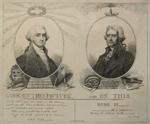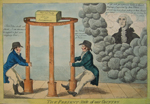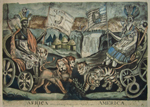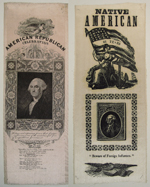|
Section I Selections from the C.W. McAlpin Collection
Section I Selections from the C. W. McAlpin CollectionSection VIIIWashington’s Legacy Washington was the only president in the history of the United States to be elected by a unanimous vote. It was inevitable, following his death, that the general solidarity that had fostered the Revolution and the birth of the republic would give way to increasingly different opinions on the best interests of the new nation. Washington’s image was often appropriated to endorse or discredit a particular viewpoint.
During Washington’s second term as president, the divide between the government’s two political parties grew deeper. The Federalists, led by Alexander Hamilton, favored a strong centralized government and pro-British foreign affairs, while opposing the French Revolution. The Republicans, led by Thomas Jefferson, advocated the limitation of the powers of the federal government in favor of the common man, were largely supportive of the French Revolution, and opposed close ties with Great Britain. Washington sided increasingly with the Federalists. The artist, clearly endorsing Washington, uses a passage from Shakespeare’s Hamlet to associate Washington with the play’s late King Hamlet, and Jefferson with the king’s villainous brother and successor, King Claudius. Below Washington’s portrait are three books simply bearing the words “Order,” “Law,” and “Religion,” flanked by a lion and an eagle, representing Great Britain and the United States. The books and papers beneath Jefferson refer to the contemporary intellectual and controversial figures Thomas Paine, Condorcet, Voltaire, and Jefferson himself, as well as to Philip Mazzei, the recipient of a letter from Jefferson that firmly criticized Federalist leaders and caused a political scandal. The snake and alligator are symbols of strife and aggression.
Best known for his cartoons of the War of 1812, Edinburgh-born Charles left Britain around 1805, apparently to avoid persecution for his political cartoons. From 1806 to 1814 he worked in New York, then in Philadelphia, where he remained for the rest of his life. The War of 1812, a three-year armed conflict between the United States and Great Britain, was a direct result of friction between the two countries over certain aspects of the French Revolution and the Napoleonic Wars. Charles portrays the United States’ involvement as a perilous situation that risks dismantling the very foundations on which the country was built.
This print is part of a set depicting the “Four Continents.” The companion print would have portrayed Europe and Asia. The artist, intentionally or not, bluntly produces a face-off of flags. That held by the figure of Africa proclaims “Slave Trade abolish’d in England 1806,” while America’s flag features the stars and stripes with a medallion portrait of George Washington who, by the time of his death, reputedly had 317 slaves at Mount Vernon. In actuality, the Slave Trade Act in Britain was not passed until 1807, and was extended to the entire British Empire with the Abolition Act of 1833. The prohibition of foreign slave trade was instituted in the United States in 1808, but it was not until 1863, with the Emancipation Proclamation, that slavery was abolished throughout the country.
Anonymous (American, 19th century) An increase in immigration in the eastern United States in the 1840s sparked an opposition movement known as Nativism, initiated primarily by Anglo-Saxon Protestants who objected to the influx of Roman Catholics, especially the Irish. The American Republican party, founded by Nativists in 1843 in New York, was adopted in nearby states as the Native American party. Various secret Nativist societies were also formed, such as the Order of the Star Spangled Banner, whose membership was open only to Protestant men 21 years of age or older (hence the slogan “21 Years”). Such societies aimed to make foreign-born Americans ineligible for elected office, and to require a 25-year residence for citizenship. The designers of these badges sought to validate the Nativist agenda by associating it with Washington. The source for both portraits is Stuart’s “Athenaeum.” “Beware of foreign influence” is a frequently appropriated misquotation of Washington’s farewell address. The American Republican badge also includes verses from Walter Scott’s The Lay of the Last Minstrel and James Gates Percival’s New England. |




